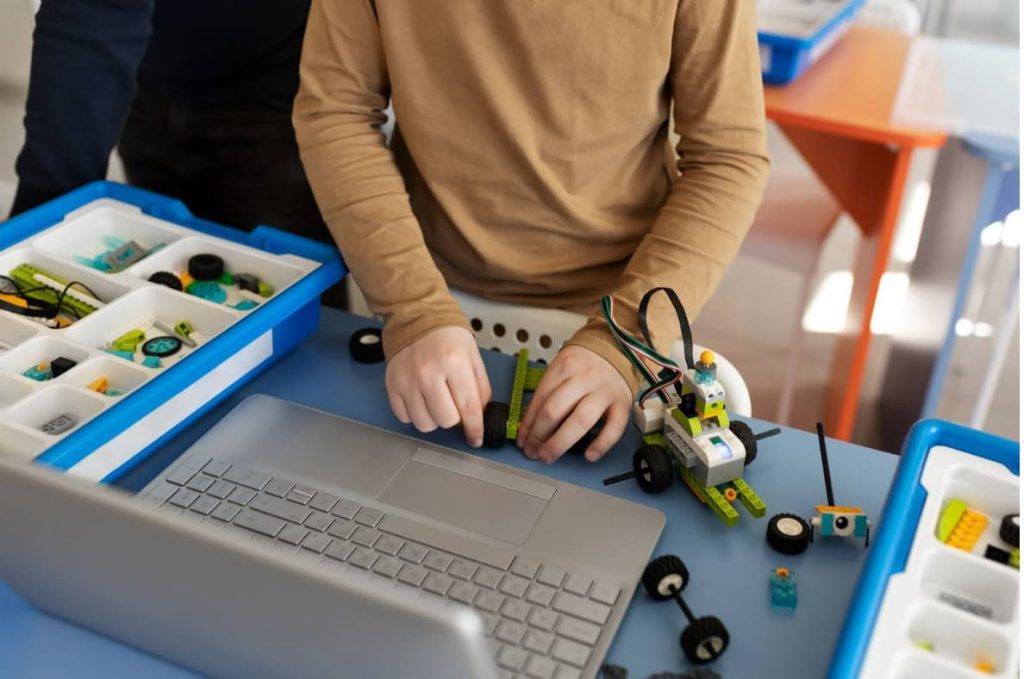Categories:
Computational thinking is an essential skill in today’s education, not just focused on learning to code, but on developing problem-solving and logical thinking abilities. Integrating it into the classroom, from early childhood through secondary education, will equip students with key competencies for their personal and professional futures. Throughout this article, you’ll discover how to foster this skill and its benefits for students’ overall development.
What is Computational Thinking?
Computational thinking is a way of approaching problems in a logical and structured manner, much like how programmers do. However, as mentioned earlier, it’s not just about learning to code. Computational thinking involves breaking down a large problem into smaller parts, recognizing patterns, and then designing efficient solutions to solve those problems. Simply put, it allows you to organize and simplify complex issues, which is applicable to any field, not just technology.
This skill is becoming increasingly important in a world where technology is intertwined with daily life. It not only helps students improve their problem-solving abilities, but also fosters creativity and innovation, two competencies that will be vital in the future job market.
What Are the Key Elements of Computational Thinking?
Developing this competency in students involves focusing on four key pillars:
- Decomposition: This teaches students to break down a large or complex concern into smaller, more manageable parts. For example, when faced with the challenge of organizing a school fair, you can break it down into sub-tasks like coordinating booths, organizing volunteers, and preparing the space. Teaching students this skill allows them to tackle larger tasks with more confidence.
- Pattern Recognition: When you can identify patterns or similarities in different problems, it becomes easier to find quick solutions. In the classroom, this helps students make connections between what they already know and new concepts.
- Abstraction: This skill involves focusing on the essential aspects of a difficulty while leaving out unnecessary details. Teaching this helps students concentrate on what truly matters, ignoring distractions that don’t contribute to the solution.
- Algorithm Design: An algorithm is simply a set of steps to solve a problem. With computational thinking, you teach students to create clear and orderly instructions to solve the problems they face.
These pillars not only prepare students for a digital future but also enhance their ability to think logically, structurally, and efficiently.
How to Integrate Computational Thinking into the Classroom
Incorporating this skill into the classroom doesn’t require you to be an expert in programming or advanced technology. In fact, you can start with small steps tailored to each educational level. Here’s how you might apply it at different stages.
Computational Thinking by Learning Stage
- Early Childhood Education: At this stage, children can begin developing computational thinking through play and fun activities. Building games, puzzles, and block games are excellent tools. Through these activities, children start to understand concepts like decomposition and sequences, even if they don’t yet have the technical vocabulary.
- Primary Education: At this age, you can start introducing more formal concepts. Tools like Scratch, a visual programming platform, are ideal for students to start developing problem-solving skills. By creating their own games or interactive stories, they naturally apply the principles of computational thinking.
- Secondary Education: At this stage, students can begin working with more complex programming languages like Python or JavaScript and apply computational thinking to more advanced projects, such as app design or building robots. Additionally, it’s a key time to show them how these skills can be useful in any field, from biology to literature.
Regardless of the level, it’s important to foster an environment that values experimentation, mistakes, and constant improvement. Computational thinking isn’t about finding the right solution immediately; it’s about learning to explore different approaches and improve with each attempt.
Why is it Important to Integrate Computational Thinking from Early Childhood through Secondary Education?
The key to students fully benefiting from this skill is starting at an early age and continuing to develop it throughout their academic journey. Beginning in early childhood education with playful activities and progressing to more complex projects in secondary education provides students with a solid foundation that will be useful in their academic and professional futures.
By integrating computational thinking into all stages of education, you’re not only preparing students to face future challenges, but also giving them the tools they need to be effective, innovative, and collaborative problem solvers.
Benefits of Computational Thinking for the Future of Education
Incorporating computational thinking into education offers a range of benefits that go far beyond simply learning to code. Developing this skill prepares students to face future challenges while helping them develop key abilities, such as:
- Critical Thinking and Problem-Solving: By learning to break down problems and analyze solutions, students develop critical thinking skills that they can apply in any situation.
- Creativity and Innovation: Fostering computational thinking encourages students to be more creative. By designing their own projects and solutions, they are constantly testing new ideas and innovating in their approaches.
- Collaboration: Many projects that incorporate computational thinking, such as developing programs or building robots, require collaboration among peers. This teaches students to work as a team and share ideas effectively.
- Preparation for the Job Market: While not all students will become programmers, computational thinking skills will be essential in many careers of the future. From data science to graphic design, the ability to solve problems efficiently is highly valued.
In conclusion, computational thinking is key to preparing students for the future. From problem-solving skills to creativity and collaboration, integrating this approach into the classroom offers countless benefits. By starting in early childhood education and continuing to develop these skills through primary and secondary education, you’ll be giving your students a strong foundation to face the challenges of a rapidly changing world.
